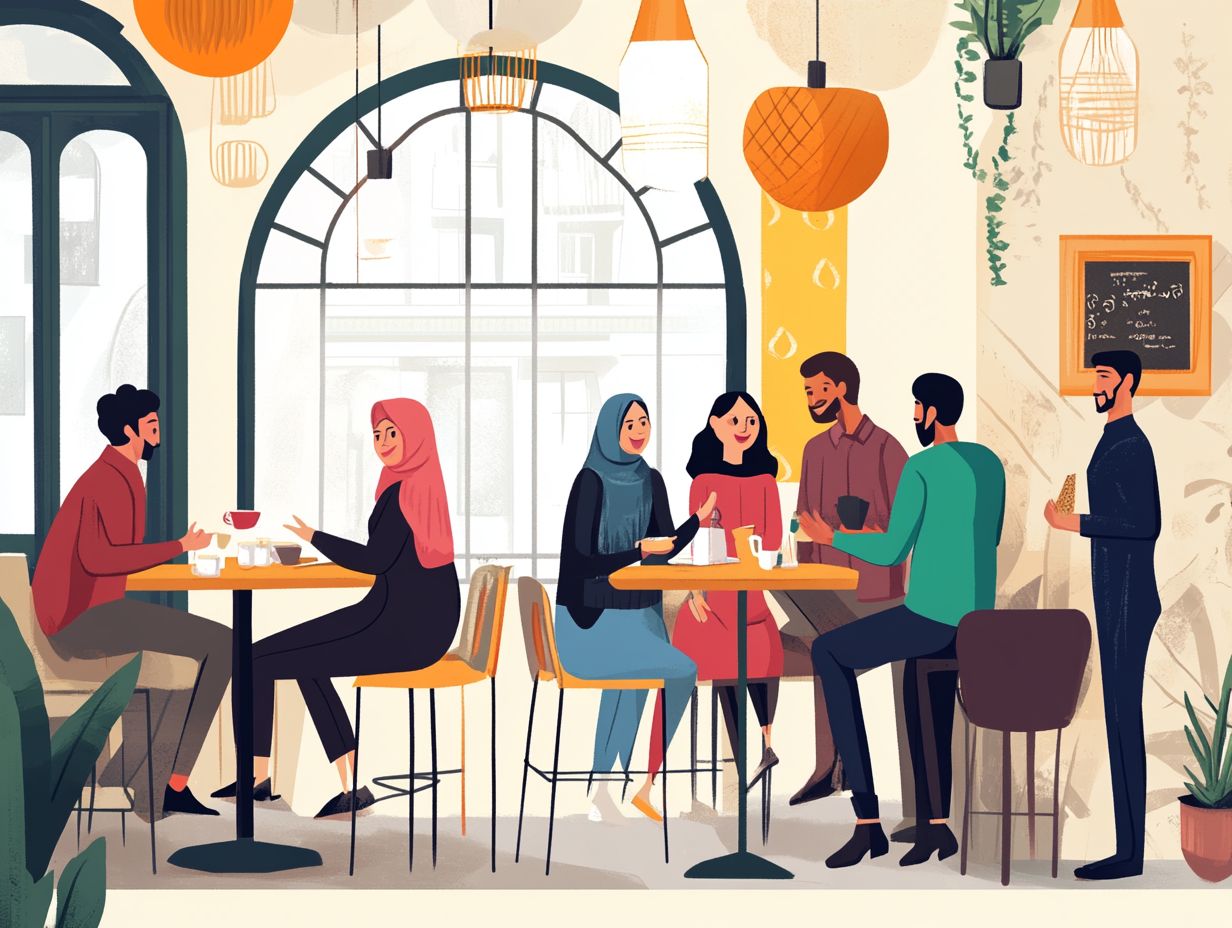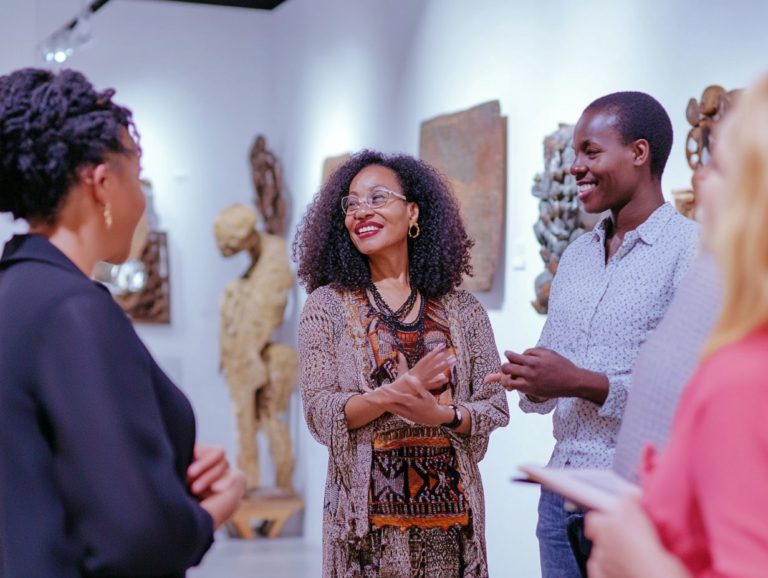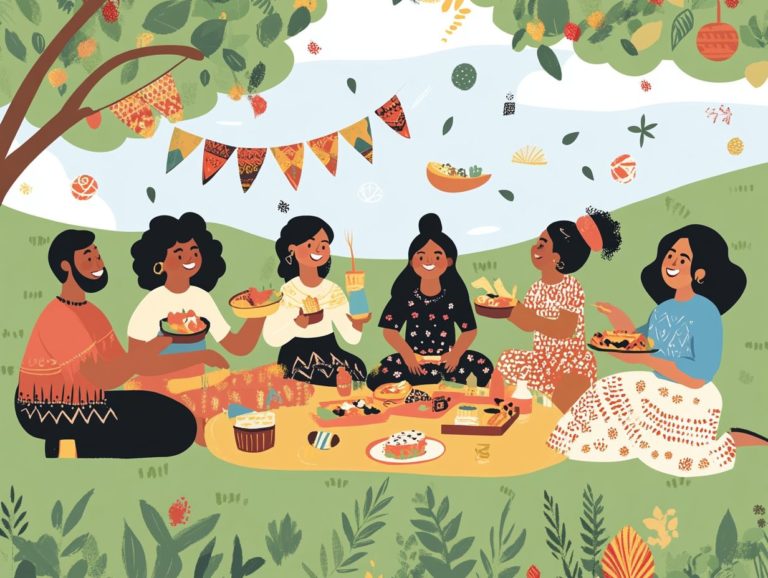Adjusting to Local Etiquette: What You Need to Know
When you venture into new places or engage with diverse communities, grasping local etiquette can elevate your experience and cultivate meaningful relationships.
This article delves into essential cultural norms, addressing everything from effective communication and nonverbal cues to dining customs and appropriate attire.
You ll uncover vital do’s and don ts, insights into social interactions such as greetings and gift-giving, and valuable tips for navigating unique customs.
Embracing these practices not only demonstrates respect but also enhances the richness of your travels and interactions.
Contents
- Key Takeaways:
- Understanding Local Etiquette
- Researching the Culture
- Communicating Effectively
- Dining Etiquette
- Dress to Impress: Understanding Local Styles
- Respecting Cultural Norms
- Handling Social Interactions
- Frequently Asked Questions
- What is local etiquette and why is it important to adjust to it?
- How can I learn about the local etiquette before traveling to a new place?
- What are some common etiquette rules that travelers should be aware of?
- What should I do if I accidentally offend someone with my behavior?
- Is it necessary to completely conform to the local etiquette or can I still maintain some of my own customs?
- What if I am unsure about a specific etiquette rule while traveling?
Key Takeaways:

- Respect the local culture by understanding and following their etiquette. It shows your appreciation and helps you avoid unintentional offense.
- Research the do’s and don ts of the culture to avoid cultural faux pas. Pay attention to nonverbal cues and gestures to communicate effectively.
- Be mindful of dining and dressing etiquette to show respect for cultural norms. Take note of greetings and gift-giving customs for successful social interactions.
Understanding Local Etiquette
Understanding local etiquette is essential for anyone eager to immerse themselves in a new culture. It involves navigating the intricate web of cultural norms, social etiquette, and local customs that shape daily interactions, as outlined in understanding local customs: a student’s guide.
From the nuances of greetings to the subtleties of nonverbal communication, each culture boasts its own unique practices. By grasping these nuances, you enhance your communication and cultivate deeper connections while demonstrating respect for the community’s traditions.
This awareness ultimately enriches your travel experience and fosters meaningful cultural exchange.
Why is it Important?
Understanding the significance of local etiquette is pivotal, as it directly influences cultural sensitivity and enhances your ability to engage effectively in diverse social contexts. For more insights, check out what you should know about local work culture.
Immersing yourself in the customs and practices of those around you boosts your social competence and cultivates a profound appreciation for varying perspectives. Overlooking these subtleties can lead to misunderstandings that jeopardize relationships and obstruct meaningful communication.
By recognizing and respecting cultural differences, you demonstrate a commitment to inclusivity and empathy. This lays a solid foundation for stronger connections and helps you navigate various social environments, making you more adaptable and open-minded.
Researching the Culture
Researching the culture of your destination is an essential step in your journey. It equips you with an understanding of the culture necessary to thrive in diverse environments.
By tapping into online resources, travel blogs, and academic studies, you gain invaluable insights into local customs, traditions, and social etiquette.
This proactive approach enables you to adapt gracefully, fostering a deep respect for the unique traditions and practices that each community holds dear.
Do’s and Don’ts
Recognizing the do’s and don’ts of local culture is essential for effective learning and successful integration into new social settings. Cultural etiquette tips for international students can help you avoid cultural faux pas and foster positive interactions.
For example, visiting a country where bowing is customary and offering a handshake might come across as disrespectful. Understanding these nuances can enhance your communication and relationship-building efforts.
Be mindful of dress codes; in some cultures, modest attire is expected in places of worship. Similarly, avoiding disruptions during locals’ prayers or personal time shows respect and consideration.
On the flip side, an embarrassing misstep, such as attempting to take photographs in restricted areas, can have serious consequences. By committing to respect local customs, from simple greetings to dining etiquette, you open the door to enriching experiences that deepen your understanding and appreciation of the culture around you.
Don’t miss out on these invaluable connections! Explore more about local etiquette before your next trip.
Communicating Effectively

Mastering effective communication is essential in cross-cultural interactions. It allows you to navigate diverse communication styles and cultivate a better understanding of different cultures.
This mastery includes both verbal and nonverbal communication. Nonverbal communication, or how we communicate without words, includes gestures and facial expressions, and it often conveys messages that words alone cannot.
By prioritizing cultural sensitivity and adapting your communication strategies, you can forge deeper connections. This ensures your messages resonate as intended.
Nonverbal Cues and Gestures
Understanding nonverbal cues and gestures is crucial. These cues often carry significant cultural meanings that can differ dramatically across various societies.
Take, for example, a simple smile. In many Western cultures, it s seen as an expression of friendliness. However, in certain East Asian contexts, it may actually signify embarrassment or discomfort.
Similarly, handling eye contact can convey differing levels of respect. In some cultures, maintaining eye contact reflects confidence and engagement, while in others, it might be perceived as intrusive or disrespectful.
Being attuned to these nuances in body language is essential for effective communication. It helps you navigate social interactions with sensitivity to cultural norms and etiquette.
This ultimately fosters a deeper mutual understanding and connection.
Dining Etiquette
Dining etiquette is vital! It beautifully reflects the heart of cultural traditions, showcasing the values and social norms of a community.
It encompasses a range of practices, from table manners to food etiquette. By understanding the specific dining customs of a culture, you enhance your dining experience.
Not only do you elevate your experience, but you also demonstrate respect for the rich traditions that shape social interactions around the table. Each culture has unique customs that influence everything from how food is served to the expected behavior of guests.
Embracing these nuances can elevate your appreciation for the culinary experience and the connections formed during meals.
Table Manners and Customs
Table manners embody the unwritten rules of dining etiquette, varying significantly across cultures. These customs dictate how food should be consumed and how guests should engage at the table.
Take Japan, for example slurping noodles there is not just acceptable; it’s a compliment to the chef. In contrast, many Western countries might frown upon such a practice as impolite.
In Middle Eastern cultures, sharing food from a common plate is a gesture of friendship and hospitality, strengthening communal bonds.
Understanding and adhering to these traditions is crucial. They cultivate respect and appreciation among individuals from diverse backgrounds.
By embracing these various dining customs, you can navigate social gatherings with finesse. This ensures your interactions at the table leave a memorable, positive impression.
Dress to Impress: Understanding Local Styles
Dressing appropriately transcends mere personal style; it is intricately linked to cultural norms and expectations that differ markedly across societies.
For travelers, grasping local dress codes is essential. It signifies respect for cultural values, gender roles, and the social dynamics of a specific environment.
When you align your attire with local customs, you not only enhance your cultural adaptation but also foster more positive social interactions.
Take a moment to learn about the dressing customs before your next trip!
Respecting Cultural Norms

Respecting cultural norms is about more than just acknowledging them; it s about actively adapting your behavior and appearance to harmonize with local practices, especially when it comes to dressing appropriately.
For example, in many Middle Eastern countries, women are expected to wear modest clothing that covers their arms and legs. This reflects deeply held values and beliefs regarding women’s roles in society. In contrast, in certain Western cultures, casual attire like jeans and t-shirts may be acceptable for various occasions.
Understanding these nuances of what constitutes appropriate attire can significantly enhance your personal interactions. It showcases cultural sensitivity and respect for others’ personal space.
When you travel or engage with diverse communities, being aware of these different standards fosters goodwill and deepens connections. A thoughtful approach to your appearance can truly bridge cultural divides and create meaningful relationships.
Handling Social Interactions
Navigating social interactions with finesse demands a keen understanding of local customs, especially in greetings and gift-giving practices. These nuances can vary significantly across cultures, and being aware of them will enhance your interpersonal connections.
Greetings and Gift Giving
Greetings and gift-giving customs are foundational elements of social interactions, offering profound insights into a culture’s values and practices.
By understanding how different cultures express goodwill, you gain valuable perspectives on their worldviews and how people interact. For example, in Japan, the ritual of exchanging business cards is steeped in formality, underscoring respect and the importance of hierarchy and relationship-building. In contrast, many Western cultures embrace a firm handshake as a common greeting, which conveys confidence and equality.
Gift-giving customs also showcase significant variation. In some Middle Eastern cultures, gifts are presented exclusively with the right hand, symbolizing respect and honor. These interesting practices show how we respect each other s traditions and reveal individual preferences regarding personal space and interaction.
By recognizing these subtle nuances, you can enhance your communication between cultures and cultivate deeper connections with individuals from diverse backgrounds.
Frequently Asked Questions
What is local etiquette and why is it important to adjust to it?
Local etiquette refers to the customary behaviors and manners expected in a specific location or culture. Understanding cultural etiquette tips shows respect for the people and their customs, helps avoid misunderstandings, and allows for smoother interactions.
How can I learn about the local etiquette before traveling to a new place?

Researching online, reading travel guides, or asking locals or expats are great ways to learn about local customs before traveling. You can also observe how others behave and adapt accordingly.
What are some common etiquette rules that travelers should be aware of?
Some common etiquette rules include respecting personal space, greeting with appropriate phrases, using proper table manners, and removing shoes before entering someone’s home. You must be aware of any cultural or religious customs, such as dress codes or taboos.
What should I do if I accidentally offend someone with my behavior?
If you accidentally offend someone, apologize sincerely and try to understand what you did wrong. Showing genuine remorse and making an effort to correct your behavior can go a long way in repairing the situation.
Is it necessary to completely conform to the local etiquette or can I still maintain some of my own customs?
While it s important to show respect for local customs, it s also okay to maintain some of your own customs. However, be mindful of how they may be perceived and try to adapt them to fit within the local culture.
What if I am unsure about a specific etiquette rule while traveling?
If you’re unsure about a specific etiquette rule, watch what others do.
You can also ask questions politely; people usually appreciate your interest in their culture!






